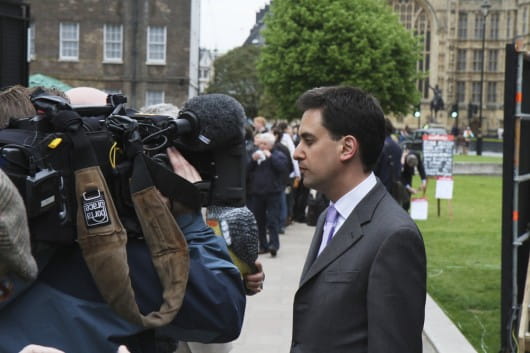Labour moves to the left Tories flee to the right GE2015 countdown
With just twelve days to go until the 2015 General Election, expect to see both major parties return to the comfort of their respective sides […]
With just twelve days to go until the 2015 General Election, expect to see both major parties return to the comfort of their respective sides […]
With just twelve days to go until the 2015 General Election, expect to see both major parties return to the comfort of their respective sides within the political scale in an effort to re-acquire swing voters from minority parties.
This election sees, for the first time, minor parties take a significant share of votes away from major parties, splitting the vote and now likely to result in the failure of both the Conservatives and Labour party in winning a majority (326 seats in the House of Commons). This will force both parties to negotiate a coalition with minor parties including the Liberal Democrats, UKIP, SNP and the Greens.
But as the election enters the final stretch, I fully expect both Labour and Tories to return to their ideological homes on the political scale.
Make no mistake, minor parties are splitting the majority vote in crucial constituencies. The Labour dominance in Scotland is set to be decimated by the SNP, who could win as many as 45 to 50 seats with Labour losing around 25-30 seats. The maths behind the loss of these crucial seats will ensure Labour does not win a majority. I expect Labour to win as many as 285 seats in total, which leaves them 41 seats short of the majority needed to win.

Labour needs to start re-appealing to leftist SNP voters and swaying Lib Dem voters who abandoned the Labour party five years ago having been seduced by Nick Clegg’s strong campaign performance. Not only will this be a tactic to acquire swaying voters, it could also be a subtle way of paving the ground for a coalition with the SNP (who have positioned themselves as more leftist than Miliband), should they need it.
Will this work? I don’t think so. I believe the SNP vote is fairly well entrenched right now and unlikely to move significantly down or up. The Lib Dems are polling at 7% of the vote. Compare this to 27% of the vote the Lib Dems polled at in 2010 and you can see how far they have slid. I don’t foresee Lib Dem voters abandoning them any more than they have done so already.
In much the same fashion that Labour will start to move to the left, the Tories need to move back to the right. Why? Because they are concerned about UKIP stealing traditional Tory voters. UKIP are currently polling at 17% and whilst they remain expected to only win a handful of seats, they could split the Tory vote in marginal seats and threaten how many MPs the Conservatives could retain. I expect the Tories to win around 290 seats, leaving them 36 short. That’s why you will start to hear the Tories mention England a lot more over the coming week. In fact, it’s started already with today’s announcement to move towards English voters voting for English policies. This is a clear move to sway UKIP ‘nationalist’ voters back to them.
Yet even if they do start to steal back UKIP voters, they will still be left short of the required amount to form a majority government. The game plan for the Tories is to return to polling at around 40% and hope that either there is a low turnout for Labour voters or there is a mild resurgence in the Lib Dem vote back towards around 10-15%, which would be their most preferred coalition partner.
The GBP has actually performed sturdily despite the uncertainty over who will win the election. Part of this has been down to the resilience of UK economic data over the past few weeks. For example, George Osborne hit his deficit reduction target and despite weaker than expected UK retail sales, the remainder of UK data has proved strong. The Bank of England minutes also indicated a belief that UK inflation is likely to recover from deflation quicker than expected and the Eurozone, which is the UK’s largest trading partner, is recovering more strongly. This convinced the market that the BoE remains hawkish and helped to spur more GBP buying.
See chart below showing the GBP rally 2% against a basket of other currencies in the last week.
However, as we move into the final stretch of the UK election, traders will start to tread much more nervously and the recent GBP gains may give them an excuse to take profits off the table. In the 2010 election, the GBP fell more than 1000 pips against the US dollar in the four weeks leading up to the election as uncertainty gripped. In fact, on election day itself, the GBP fell 2.8% (though much of that was also linked to the flash crash and traders seeking USD for protection).
Nevertheless, I still expect GBP to get shaky next week unless we start to see the Tories start to pull away in the polls.